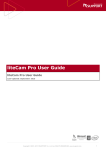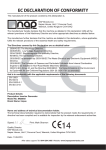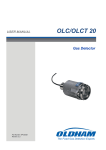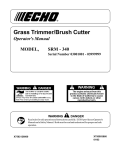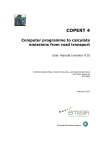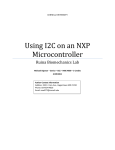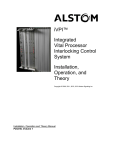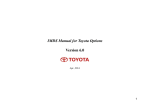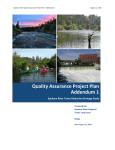Download Question to Marc
Transcript
International Vehicle Emissions Model Attachment B Development of the Correction Factors for Use in the IVE Model Notice This section of the User’s Guide describes the assumptions, options, and limitations of the correction factors in the IVE model. It is recommended that the user read and understand this section of the manual before using results of the model for any purpose. Any questions about the users guide or model may be directed to: [email protected]. This user’s guide and model may be found online at www.gssr.net/ive. B-2 Table of Contents 1. Introduction..........................................................................................................1 2. Correction Factors for Local Variables.............................................................1 3. Correction Factors for Fuel Quality Variables .................................................3 4. Correction Factors for Power Variables and Driving Behavior .....................5 5. Country Adjustment Correction Factors ..........................................................8 Appendix A. Sample Input File for Correction Factor Development Excel Worksheet: Correction Factor Data B-3 1. Introduction The basis of the emission prediction process of the IVE model is to apply a base emission rate (B) with a series of correction factors (K) to estimate the amount of pollution (Q) from a variety of vehicle types (Eq. 1). Q is the vehicle emissions in mass per unit time or distance. Q[t] = B[t]* K(1)[t] *K(2)[t]*…..K(x)[t] (Eq. 1) The correction factors can be categorized into several categories (Table 1). The development of the local and fuel quality, and power and driving correction factors are described in detail in the next sections. The changes in vehicle specific power associated with velocity profile of the vehicle is described in a separate document*. Table 1. Correction Factors Used in the IVE Model Local Variables Fuel Quality Variables Power & Driving Variables Ambient Temperature Gasoline Overall Vehicle Specific Power* Ambient Humidity Gasoline Sulfur Road Grade Altitude Gasoline Lead Air Conditioning Usage Inspection/Maintenance Programs Gasoline Benzene Start Distribution Gasoline Oxygenate Diesel Overall Diesel Sulfur *Described in a separate IVE Document, “Characterizing the Effect of Driving Behavior on Emissions from On-Road Vehicles” Most correction factors are developed using data from existing models. In this process, correction factors are developed by ratioing the emissions with the indicated parameter modeled to the base emissions for each technology. This ratio then stored in the IVE source code and used in Equation 1 as the user selects each option. 2. Correction Factors for Local Variables A list of the correction factors options for each correction factor associated with Local variables is listed in Table 2. Italicized values indicate the default setting in the model. Table 2. Correction Factor Options for Local Variables Inspection/Maintenance (I/M) none idle decentralized (passenger veh.) idle centralized (passenger veh.) loaded centralized (passenger veh.) idle decentralized (passenger veh. & 2/3 wheelers) idle centralized (passenger veh. & 2/3 wheelers) loaded centralized (passenger veh. & 2/3 wheelers) idle decentralized (all vehicles) idle centralized (all vehicles) Ambient Temperature (25C) Any Integer B-4 Relative Humidity Altitude (50%) Any value between 0-100% Low High loaded centralized (all vehicles) Inspection/Maintenance(I/M) Data from the United States programs were also used to develop approximate adjustments to each of the inspection maintenance categories. These corrections are approximate and could change depending upon the effectiveness and stringency of the program among other variables. The corrections for these variables for each vehicle technology and pollutant are listed in Appendices C-F. Where there is a correction, pollutant, or vehicle type omitted, there is no correction applied in the IVE model for this variable. There are further adjustments that are made to the I/M correction factor in the I/M subroutine. These adjustments respond to fuel adjustments. The corrections that are impacted are those for CO, VOC, PM, 1,3 Butadiene, Acetaldehyde, Formaldehyde, Benzene, and CH4. Once an I/M correction factor is selected, this adjustment is made to the I/M correction factor before the value is returned from the routine. The formula for adjusting the credits is shown in Equation 2 and Table 3. New I/M Correction Factor = 1 - F + F*Original I/M Correction Factor (Eq. 2) Table 3. Calculating the Variable F in the I/M Correction Factor Equation For oxygenates For overall fuel For combined oxygenates and overall fuel quality quality 0% - F=1.00 Moderate - F=1.00 F = Foxygenates*Foverall fuel quality 1% - F=0.90 Clean F=0.95 2% - F=0.80 For example, for 2% oxygenates and clean 2.5% - F=0.70 fuel, F = 0.76. Ambient Temperature, Relative Humidity, and Altitude The methodology for using MOBILE6 for use in developing correction factors for the ambient temperature, relative humidity, and altitude is as follows: A MOBILE6.2 input file is created for the default scenario and each selection for humidity, etc. (Appendix A). The default for input file uses the database (.TB1) output formats with additional options for the database output of: Aggregated Output, Daily Output, and With Fieldnames. Other default settings required are listed in Table 4. Emissions predicted in g/mi or grams/start are then ratioed for each of the 28 vehicle classes to produce correction factors. The correction factors for the 28 vehicle classes are then mapped to the appropriate IVE technology category and hard coded into the model (IVE 2003). In the IVE model, evaporative VOC is treated as a separate pollutant and is categorized into either running or start emission rates. B-5 Table 4. Some Input Options Selected in modeling Correction Factors using MOBILE6 model. Database Emissionsby emission type classifications Running-Exhaust Running Emissions Start-Exhaust Engine Start Emissions (trip start) Hot Soak-Evaporative Hot Soak Emissions (trip end) Diurnal-Evaporative Diurnal Emissions (heat rise) Resting-Evaporative Resting Loss Emissions (heat rise) Run Loss-Evaporative Running Loss Emissions Crankcase-Evaporative Crankcase Emissions (blowby) Refueling-Evaporative Refueling Emissions (fuel displacement and spillage) Database Facilitiesby facility type Arterial-Arterial and Collector Roadways None- For start and some evaporative emissions 3. Correction Factors for Fuel Quality Variables A list of the options for each correction factor associated with Local variables is listed in Table 5. Italicized values indicate the default setting in the model. The corrections for each of these Fuel Quality variables for each vehicle technology are presented in Appendices G –M. Table 5. Correction Factor Options for Fuel Quality Variables Gasoline Gasoline Gasoline Overall Lead Sulfur moderate/premixed 2None Moderate stroke (300 ppm) clean/premixed 2-stroke Low Low (50 ppm) High super low moderate/non-premixed 2-stroke (15 ppm) Clean/non-premixed 2- MMT High stroke (600 ppm) Gasoline Benzene Moderate (1.5%) Low (0.5%) super low (0.2%) High (3.0%) Gasoline Oxygenate 0% Diesel Overall moderate 1% Clean 2% biodiesel 3% water emulsification Diesel Sulfur Moderate (500 ppm) Low (50 ppm) super low (15 ppm) High (5000 ppm) Gasoline Overall As seen in Table 5, there are four options for Gasoline Overall Fuel Quality. They are a combination of moderate and clean gasoline, and premixed and non-premixed gasoline. The latter option refers only to 2-stroke small engines where oil mixed with gasoline is required for the vehicle to operate. Premixed gasoline refers to the situation where the oil is mixed prior to purchase at the fuel pump. Non-premixed gasoline refers to when the vehicle operator must mix his own gasoline and oil. Premixed gasoline is usually of better quality because the amount and quality of the mix is closely regulated. The clean gasoline correction factors will affect all gasoline vehicles except for 2-stroke small engine vehicles. The pollutants affected by the overall gasoline variables include CO, VOC, VOC evaporative, PM, 1-3 butadiene, benzene, acetaldehyde, formaldehyde, and methane. It was assumed that clean fuel will reduce these emissions by 3% and premixed fuel will reduce these emissions also by 3%. Supporting documentation for these assumptions include the MOBILE6 model for various fuel quality mixtures and B-6 documentation from India and Asia on the effects of premixing fuels (GIA 2002, Kojima, 2002, Kojima 2000). Gasoline Lead The gasoline lead content will affect lead emissions. The lead correction factor is simply the ratio of the lead in the fuel to the default fuel. The default is 0.7 g lead per liter fuel. The high lead is 2 g/L, therefore the correction factor for high lead is 2.86. The default lead content is zero, and the correction factor is zero for all vehicles for the default option. Additionally, lead in any amount in the gasoline will render catalysts ineffective. Therefore, lead content will affect CO, VOC, 1,3 butadiene, benzene, formaldehyde, acetaldehyde, and benzene emissions for 2-way catalytic vehicles. For 3-way catalytic vehicles, the lead content will affect these pollutants and NOx emissions also. The correction factor applied will render emissions equivalent to a non-catalyst vehicle in the presence of lead. PM emissions were assumed to not be affected by lead content. Gasoline Sulfur The gasoline sulfur content directly impacts the amount of SOx emissions, and also affects the formation of NH3 and N20 emisisons. The default sulfur content is 300 ppm. The high sulfur content is 600 ppm, low is 50 ppm, and super low is 15 ppm. Therefore, the correction factors for start and running SOx emissions are 2, 0.17, and 0.05 respectively for all gasoline fueled vehicles. Additionally, the sulfur content will affect the performance of catalysts, therefore affecting CO, VOC, NOx, 1,3 butadiene, benzene, formaldehyde, acetaldehyde, and benzene. Low and superlow levels of sulfur in the gasoline reduce these emissions and high sulfur increases these emissions. The quantity of the change was calculated by varying the sulfur content in the MOBILE6 model and varies by technology. Gasoline Benzene The gasoline benzene content directly impacts the amount of benzene emissions. The default benzene content is 1.5%. The high benzene content is 3% ppm, low is 0.5% ppm, and super low is 0.2% ppm. Therefore, the correction factors for start and running benzene emissions are 2, 0.33, and 0.13 respectively for all gasoline-fueled vehicles. Gasoline Oxygenate The gasoline oxygenate content directly impacts the amount of CO and VOC emissions. This effect will be the greatest for carbureted engines and the least for multi-fueled injected engines. The default oxygenate content is 0%. The other options are 1%, 2%, and 3% oxygenate content in the fuel. Gasoline oxygenate content will also affect the benefits associated with I/M programs (see I/M section). 1,3 Butadiene will be affected the same as VOC emissions. All other pollutants will not be affected by changes in oxygenate content. The CO and VOC changes associated with varying oxygenate were developed from the MOBILE6 model as described in section 2. These corrections can be viewed in the excel attachment. B-7 Diesel Overall Diesel overall fuel quality includes a clean general fuel quality options and biodiesel and water emulsification options. The general Overall diesel fuel quality will impact PM, VOC, CO, 1,3Butadiene, Acetaldehyde, Formaldehyde, Benzene emissions. The diesel clean option decreases NOx emissions by 1% and all other pollutants listed by 3%. The improvements for biodiesel option were taken from the latest EPA documentation (EPA 2002). These assume a 50% benefit for CO, 40% improvement for VOC and toxics, and 60% benefit for PM emissions. However, there is a 9% increase for NOx emissions from biodiesel fuel. The effects from water emulsification have been documented in several Asian documents (GIA 2002, Kojima, 2002, Kojima 2000). These corrections are assumed to be a 15% reduction in NOx, 3% for CO, VOC, and toxics, and 50% for PM emissions. Diesel Sulfur The diesel sulfur content directly impacts the amount of SOx emissions, and will also affect NOx emissions for diesel vehicles equipped with a NOx catalyst. The default sulfur content (moderate) is 500 ppm. The high sulfur content is 5000 ppm, low is 50 ppm, and super low is 15 ppm. Therefore, the correction factors for start and running SOx emissions are 10, 0.1, and 0.03 respectively for all diesel fueled vehicles. For catalyst equipped vehicles, the NOx correction for high sulfur fuel is 1.1, for low sulfur 0.8, and super low sulfur is 0.7. The quantity of the NOx change was calculated by varying the sulfur content in the MOBILE6 model and varies by technology. 4. Correction Factors for Power Variables and Driving Behavior In addition to fuel and local variables, certain conditions affect the load on the engine and therefore effect emissions. These include driving patterns, use of air conditioning, and road grade. Shown in Table 6 are the power options incorporated into the model. Also described in this section is the effect of starts on emissions, listed as soak categories. As an engine cools, the emissions from start up will change. Both the power and start corrections for each technology type are listed in Appendices N, O, and P. Table 6. Correction Factor Categories for Power Variables & Driving Behavior Vehicle Specific Power (VSP) Soak Distribution Driving Distribution 60 bins: 20 VSP bins from -40 to +50 10 bins: soak times kW/ton and 3 Engine Stress Bins from 12 hours to 5 minutes Road Grade -10% to +10% Air Conditioning On or Off Vehicle Specific Power (VSP) Driving Distribution Modeling the effect of driving behavior on emissions is treated differently than the other correction factors. There are sixty bins allocated to different driving conditions. The driving condition is defined by vehicle specific power and engine stress, parameters which are developed from second by second velocity profiles of the vehicle. The fraction of driving in each bin is either measured or assumed and is required input to the model. Each bin has a different correction factor for each pollutant and vehicle type. The B-8 description of how each correction factor is developed and why the vehicle specific power and engine stress parameters were chosen is described in a separate IVE report: “Characterizing the Effect of Driving Behavior on Emissions from On-Road Vehicles”. In addition, the characterization of the driving pattern distribution for Nairobi, Kenya and Santiago, Chile are described in the IVE reports “Characterization of Driving Behavior and its Effect on Emissions”, “Pune Vehicle Activity Study”, “Nairobi Vehicle Activity Study”, and “Santiago Vehicle Activity Study”, located on the web at www.gssr.net\ive. Soak Distribution The IVE model has base start emission rates defined as emissions in grams for a completely cold start. However, because the emissions vary as a function of soak time, a soak correction factor containing 10 bins for a variety of soak times from 12 hours to 5 minutes are contained in the IVE model. The location file contains the number of starts and the soak distribution that occur at each time of day. The correction factor for each bin is simply the emissions for a start with the specified soak time divided by a cold start. The information for the soak distributions was obtained from the MOBILE6 documentation (EPA 2001 (6)). The development of the soak correction factors was based on ARB’s methodology, which is the same technique used by EPA (ARB 2002). Table 7. Soak Distribution Assumed for All US Vehicles in the IVE model by Time of Day Soak Period (minutes) Start End 0 4.8 Percent of Starts in Soak Bin by Tim e of Day 6:00 AM 0.12 7:00 AM 0.18 8:00 AM 0.17 9:00 AM 0.18 10:00 11:00 12:00 AM AM PM 0.22 0.18 0.22 1:00 PM 0.19 2:00 PM 0.18 3:00 PM 0.19 4:00 PM 0.19 5:00 PM 0.22 6:00 7:00 PM PM 5:00 AM 0.15 0.14 4.8 15 0.05 0.06 0.18 0.15 0.15 0.22 0.19 0.22 0.23 0.22 0.19 0.15 0.20 0.10 15 30 0.01 0.04 0.10 0.12 0.12 0.12 0.13 0.16 0.11 0.11 0.13 0.12 0.12 0.10 30 60 0.01 0.03 0.06 0.10 0.13 0.12 0.15 0.12 0.14 0.11 0.13 0.11 0.11 0.11 60 120 0.00 0.00 0.02 0.06 0.08 0.05 0.06 0.06 0.08 0.06 0.07 0.06 0.11 0.09 120 240 0.01 0.00 0.01 0.06 0.07 0.13 0.08 0.09 0.13 0.11 0.11 0.12 0.17 0.20 240 360 0.00 0.01 0.01 0.01 0.02 0.06 0.09 0.05 0.04 0.03 0.06 0.05 0.04 0.08 360 540 0.10 0.04 0.01 0.01 0.01 0.01 0.02 0.03 0.04 0.08 0.04 0.05 0.01 0.07 540 720 0.20 0.19 0.09 0.06 0.04 0.01 0.01 0.01 0.01 0.06 0.07 0.09 0.06 0.06 720 n/a 0.50 0.46 0.38 0.24 0.15 0.09 0.06 0.07 0.04 0.02 0.02 0.01 0.02 0.05 Total 1.00 1.00 1.00 1.00 1.00 1.00 1.00 1.00 1.00 1.00 1.00 1.00 1.00 1.00 Percent of Starts in Each Time Period 2.04 5.54 6.02 4.73 5.16 6.72 8.07 7.3 8.04 8.98 8.41 7.73 6.02 15.24 Road Grade The IVE model has been designed to use correction factors to model differences due to driving behavior and operating mode. The driving correction factors have been derived using 60 categories (bins) of vehicle specific power (VSP) and engine stress levels. Inherent in calculating VSP is estimating the engine load, including road grade and air conditioning usage. As part of the driving pattern development, the user has the option of inputting second by second velocity and road grades to estimate the VSP/stress distribution for each scenario desired. If the user prefers not to use road grade this way, an alternate “average” road grade may be specified in the location files. The valid inputs are –14% to +14%. If an “average” road grade is input, the change in VSP associated B-9 with that road grade will be estimated and applied to the entire analysis. The VSP increase associated with road grade is calculated using Equation 3. VSPrg = v9.81 (atan(sin(grade))) (Eq. 3) VSPrg = Increased load associated with road grade grade = (ht=0 – ht=-1)/( v (t=-1to0) )* t(t=-1to0)) v = velocity (m/s) h = Altitude (m) t = time (s) (typically 1 second) Air Conditioning The use of air conditioning is treated similarly to grade effects in the IVE model. A VSP/stress bin distribution is calculated with an increased load associated with using the AC unit. An “ACon” emission factor is then estimated for each technology vehicle based on this new power distribution. The fleet file contains information on the number of vehicles that are equipped with air conditioning, and the location file contains information on the ambient temperature and describes how much the fleet will use the air conditioning. The appropriate percentage of the vehicles in each technology category is applied to the ACon Emission Factor, while the remaining portion of the fleet uses the ACoff emission factor. The increased load associated with Air Conditioning use is estimated in the following manner: VSPac = COF * VSPcomp (Eq. 4) where VSPac = Averaged Increased Load due to operation of an AC unit COF = Compressor On Fraction VSPcomp = Increased load of AC compressor Velocity is assumed to impact the efficiency of the AC compressor, therefore decreasing the load (VSPcomp) placed on the engine from the AC unit at high speeds. The load on the engine due to operating the AC compressor is assumed to be 3 kW/ton at a speed of 9 m/s, and 2.5 kW/ton at a velocity of 14 m/s, with a linear effect of speed on AC load (Eq. 5). There is a minimum of 2 kW/ton at high velocities. These are only assumptions and as more data becomes available, these values may be changed in subsequent model versions. VSPcomp = 4-.1*v (Eq. 5) where v = average velocity (m/s) and v < 20 m/s Equation 5 estimates the increases in engine load from operating an AC compressor. The AC compressor is not on all the time. Instead, the compressor cycles on and off depending upon many variables, including the vehicle and compressor type and ambient B-10 conditions. A simplified approach for estimating compressor on fraction is to assume that it only varies linearly with temperature (Eq. 6). This is similar to EPA’s observation of compressor on fraction versus ambient temperature (EPA 2001 (9)). COF = .05*T-1 (Eq. 6) where T = ambient air temperature (degrees Celsius) and 20<T<40 Application of Load due to “Average” Road Grade and AC use The loads described above (VSPrg and VSPac) are applied to the existing VSP/stress bins. The percentage of increased VSP is applied to the original bins to create a new VSP binning distribution by linearly apportioning it to each bin (Eqs 7 & 8). While this approach is a simplification of a non-linear system, the effect on emissions and bin results are very small and therefore this approach is assumed to be a reasonable approximation. NewBFi = (1-LF)*BFi+ LF*BFi-1 (Eq. 7) LF = (VSPac + VSPrg)/binsize (Eq. 8) where BFi= Fraction of Travel in Current (ith) Bin BFi-1= Fraction of Travel in Previous Bin Binsize = Bin Size in kW/ton LF = Load Fraction For example, if a user inputs an average road grade of 2% and an average velocity of 15 m/s, and no air conditioning, the VSP increase associated with this scenario would be 2.9 kW/ton (Eq. 3). Since each bin size spans 4.1 kW/ton each, the IVE model would move 71% of the fleet up one power bin from their current position (Eq 8). So, if the original driving pattern distribution contained 5% and 11% of the driving in Bin 7 and Bin 8, respectively, the new driving pattern distribution for Bin 8, calculated from equation 7, would be 7% ((1-.71)*.11+.71*.05). An input of 0% for road grade will not consider any road grade effects in the calculation. 5. Country Adjustment Correction Factors Applying Technology Specific Non-FTP Bag Emission Rates in the IVE model The IVE model’s base emission rates are based on the United States’ Federal Test Procedure (FTP) driving cycle. A database of second by second emissions using the FTP and other cycles were used to create a separate database of the effects of different driving conditions on different technology groups. Because of the lack of sufficient second by second information, it was decided that the emissions from these driving conditions would be used relative (or normalized) to emissions seen in the LA4 cycle. It is anticipated that some users will have local data for various technologies based on a cycle other than the LA4, and that these data will not be second by second, but aggregate B-11 emissions over the cycle. When such data exists, users are encouraged to apply their own base emission rates instead of the default US based emission rates in the IVE model. The following procedure outlines the step-by-step process of applying bag rates on a non-LA4 cycle as the base emission rates for a specific set of technologies. 1. The user should edit the Location file to contain the average velocity and percent of driving in each driving pattern category. 2. The user should run the IVE model with the edited Location file and export the output. The modeler should choose options that are consistent with the dynamometer testing procedure used (i.e same temperature, humidity, fuel grade, etc.) 3. The output will contain emission rates predicted for the new cycle based on US LA4 base emission rate data. 4. Divide the measured cycle emissions by the IVE predicted emissions for each technology. 5. Insert these ratios in the Base Adjustments Tab in the IVE model. Click on the Base Adjustments Tab, go to File, New, and then add the technologies you are interested in (Figure 1 below). Save when done. Now, when you go to the Location tab and select your fleet, you can also select the Base Adjustments File to use. For every type of driving analyzed using this Fleet Profile, the results will reflect the new user-input emission rates. B-12 References 1) ARB (2002) “Methodology for Calculating and Redefining Cold and Hot Start Emissions”, June http://www.arb.ca.gov/msei/PUBS/starts.pdf 2) European Environmental Agency, European Topic Centre on Air and Climate Change (2002) “National and central estimates for air emissions from road transport” 3) European Environmental Agency, ETC/AEM (2000) “COPERT III Computer programme to calculate emissions from road transport, User’s manual 2.1” Technical report No 50 4) EPA (2001) “MOBILE6 Estimates of Exhaust Emissions for 1994-and-later Light Duty Diesel Cars and Trucks”, M6.EXH.011, EPA420-R-01-041 July 5) EPA (2001) “Determination of Start Emissions as a function of Mileage and Soak Time for 1981-1993 Model Year Light Duty Vehicles”. M6.STE.003, EPA420-R-01-058, November. 6) EPA (2001) “Soak Length Activity Factors for Start Emissions” M6.FLT.003, April EPA420-R-01-011 7) EPA (2001) “Final Determination of Hot Running Emissions from FTP Bag Emissions” M6.STE.002 EPA420-R-01-059 November 8) EPA (2001), “Basic Exhaust Emission Rates of Open Loop Vehicles for MOBILE6: Exhaust Emissions at High and Low Altitudes for Engine Starts and Running Emissions for Motorcycles, Light-Duty Diesel Vehicles and Trucks and Pre-1981 Model Year Light-Duty Gasoline Vehicles and Trucks”, M6. EXH.005 EPA420-R-01-027 April 9) EPA (2001) “Air Conditioning Activity Effects in MOBILE6” M6.ACE.001, EPA420R-01-054 November. 10) EPA (2001) “Determination of CO Basic Emission Rates, OBD and I/M Effects for Tier1 and Later LDVs and LDTs”, M6.EXH.009, EPA-420-R-01-032 April 11) EPA (2002) “MOBILE6 Technical Documentation” http://www.epa.gov/otaq/models/mobile6/m6tech.htm 12) EPA (2002) “Clean Alternative Fuels: Biodiesel”, EPA420-F-00-032, March www.afdc.nrel.gov 13) EPA (2002) “Determination of Running Emission as a Function of Mileage for 19811993 Model Year Light Duty Cars and Trucks”, M6.EXH.001, EPA420-R-02-002 January. B-13 14) EPA (2002) “Determination of NOx and HC Basic Emission Rates, OBD and I/M Effects for Tier1 and later LDVs and LDTs” M6.EXH.007, EPA420-R-01-056 November 15) EPA (2002) “Update of Heavy-Duty Engine Emission Conversion Factors for MOBILE6: Analysis of BSFCs and Calculation of Heavy-Duty Engine Emission Conversion Factors” M6.HDE.004, EPA420-R-02-005 January 16) Government of India (GIA) (2002) “Report of the Expert Committee on Auto Fuel Policy” August. 17) IVE (2003) “Creating US Fleet Files for the IVE Model”, University of California, Riverside, CE-CERT. 18) Kojima, M. C. Brandon, J. Shah (2000) “Improving Urban Air Quality in South Asia by Reducing emissions from Two-Stroke Engine Vehicles” The World Bank, December. 19) Kojima, M., et.al. (2002) “Measurement of Mass Emissions from In-use Two-Stroke Engine Three-Wheelers in South Asia” The World Bank. Society of Automotive Engineers, 02SFL-25. B-14 Appendix A. Sample Input File for Correction Factor Development B-15 MOBILE6 INPUT FILE PARTICULATES : AIR TOXICS : POLLUTANTS : SPREADSHEET : DATABASE OUTPUT : AGGREGATED OUTPUT : DAILY OUTPUT : WITH FIELDNAMES : DATABASE EMISSIONS : DATABASE FACILITIES: DATABASE VEHICLES : RUN DATA SO4 OCARBON ECARBON GASPM LEAD SO2 NH3 BUTA FORM ACET HC CO NOX 2222 2222 11 None Arterial 22222 22222222 2 222 22222222 222 SCENARIO REC : Example Input File CALENDAR YEAR * MIN/MAX TEMP FUEL RVP : 2002 PARTICLE SIZE PARTICULATE EF PMDDR1.CSV PMDDR2.CSV DIESEL SULFUR : 10.0 : PMGZML.CSV PMGDR1.CSV PMGDR2.CSV PMDZML.CSV GAS AROMATIC% GAS OLEFIN% GAS BENZENE% E200 E300 OXYGENATE : : : : : : : : : END OF RUN : : 68.0 : 7.0 84.0 : 500.0 25.0 15.0 1.5 50.0 85.0 MTBE ETBE ETOH TAME 15.1 17.6 10.0 6.0 0.50 0.05 0.45 0.00 B-16
















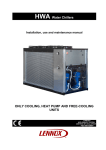
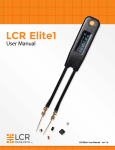
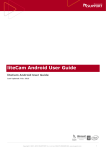
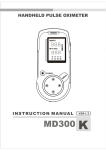

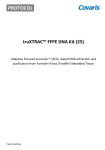
![Rii Mini [Bluetooth]](http://vs1.manualzilla.com/store/data/005730343_1-53cd9486bcc3b780c33a2a4f5175af21-150x150.png)
